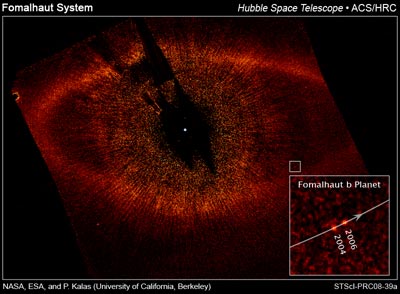
 |
Fomalhaut has long been known to be surrounded by a "debris disk" that implied a planetary system. The star itself is at the center, but is blocked out so that the faint surrounding matter can be seen. The planet, among the first ever directly imaged, is within the box at lower right. A magnified view shows a superposition of two images that reveals orbital motion. Hubble Space Telescope image: NASA, ESA, P. Kalas, J. Graham, E. Chiang, E. Kite (U. Cal. Berkeley), M. Clampin (NASA Goddard), M. Fitzgerald (Lawrence Livermore Nat'l Lab), and K. Stapelfeldt and J. Krist (NASA JPL). |